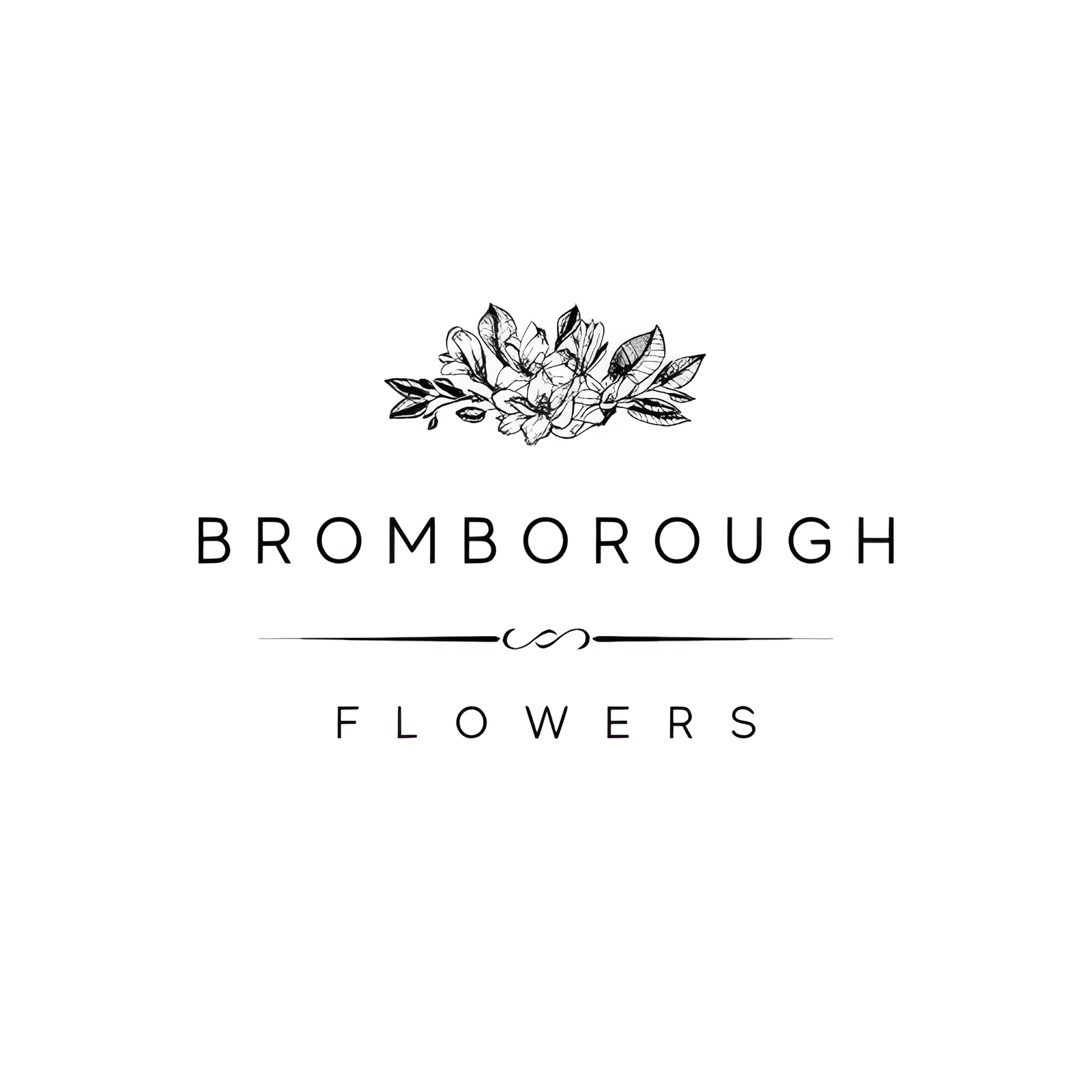When planning a wedding, the choice of flowers plays a pivotal role in setting the tone and ambiance of the event, and yarrow offers a unique blend of beauty and symbolism. This versatile member of the Asteraceae family boasts feathery foliage and an array of vibrant hues, making it an ideal candidate for various floral arrangements. Whether incorporated into bouquets, centerpieces, or boutonnieres, yarrow's year-round availability and rich cultural heritage make it a compelling option. To truly appreciate its potential and significance, one must consider its physical characteristics, historical background, and best growing conditions.
Flower Overview
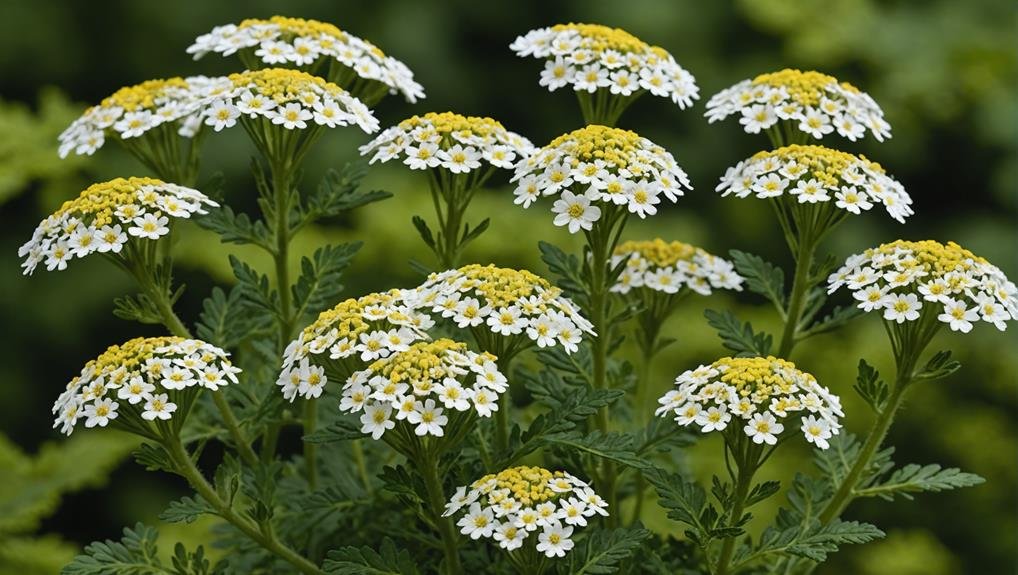
Yarrow, a member of the Asteraceae family, is renowned for its feathery foliage and vibrant hues, making it a versatile addition to any floral arrangement. Introduced to North America by early colonists, yarrow has since become a common sight in meadows and fields across the continent. Beyond its visual appeal, yarrow holds medicinal properties and historical significance, which adds a unique and meaningful touch to wedding arrangements.
Yellow yarrow, in particular, is a popular choice for weddings due to its bright, cheerful color that can enhance the overall aesthetic of any event. This variety is perfect for DIY flower projects, offering flexibility and ease of use for those who wish to create their own floral designs. Yarrow flowers are available year-round, ensuring consistent availability for wedding planners and florists.
They typically have a vase life of 7-10 days, making them a practical choice for events. Sold by the bunch, each containing around 10 stems, yarrow can be used as fillers in bouquets or as standalone arrangements.
For a rustic look, yarrow can be dried by hanging them upside down, providing longevity and a vintage charm to floral displays.
Physical Description
Featuring feathery foliage and clusters of vibrant flowers, yarrow boasts a distinctive multi-bloom structure that adds texture and color to any arrangement. Belonging to the Asteraceae family, yarrow is a perennial plant that is often found in meadows and fields. Introduced to North America by early colonists, this versatile flower has since become a staple in various floral arrangements.
Yarrow's blooms are characterized by their intricate cluster formations, with each stem reaching a length of 24-26 inches and a width of 3-4 inches. These clusters consist of numerous small flowers that collectively create a substantial and eye-catching display. The feathery foliage, which is finely divided and almost fern-like, provides an additional layer of visual interest, making yarrow an excellent filler in mixed bouquets.
Incorporating yarrow into floral arrangements not only adds aesthetic appeal but also introduces a natural and rustic charm. The flowers are particularly favored in fall designs, where their texture and structure contribute to the seasonal theme. Additionally, yarrow can be dried upside down, preserving its beauty and extending its usability in decorative arrangements for an extended period.
Available Colour Varieties
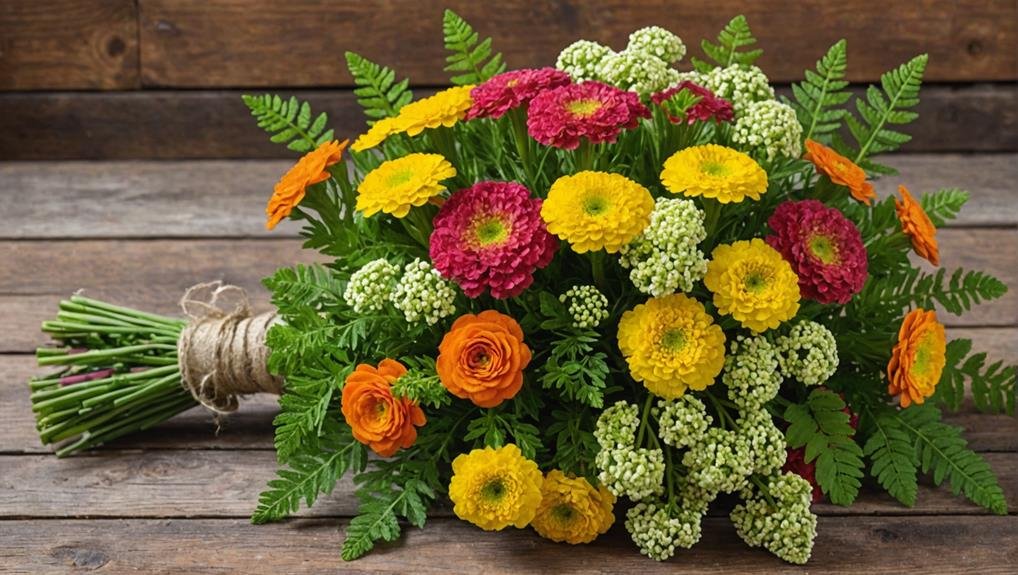
In addition to its unique structure and texture, yarrow is celebrated for its diverse color palette that enhances various floral arrangements. The range of colors yarrow offers makes it a highly versatile choice for wedding flowers, fitting seamlessly into myriad themes and color schemes. Whether you're aiming for a rustic, boho, or classic aesthetic, yarrow can easily enhance the visual appeal of your arrangements.
- White Variety: The classic white variety of yarrow is a timeless option that complements any color scheme and adds a touch of elegance and purity.
- Yellow Yarrow: Known for its deep mustard and cheerful yellow tones, yellow yarrow brings a sense of joy and optimism, making it a favorite among DIY brides.
- Pink Shades: Soft pink hues add a delicate and romantic touch to arrangements, perfect for a whimsical or vintage-themed wedding.
- Red Hues: Occasional red shades of yarrow provide a bold and striking contrast, ideal for creating dramatic and eye-catching displays.
- Pastel Tones: Subtle pastels offer a gentle and understated beauty, harmonizing well with other soft-colored flowers.
Yarrow's color adaptability allows it to be paired effortlessly with other blooms like roses, Queen Anne's Lace, Globe Thistle, Cornflowers, and Daisies, enhancing the wild, natural aesthetic of floral compositions.
Latin Name and Taxonomy
The botanical name for yarrow is Achillea, and it is a member of the Asteraceae family. This classification places yarrow among a diverse group of flowering plants known for their composite flower heads. Achillea is available in various species and cultivars, each contributing unique characteristics to floral arrangements.
The genus name Achillea is derived from the legendary Greek hero Achilles, who, according to mythology, used the plant for its healing properties on the battlefield. Achillea is available in a range of vibrant colors, including red, yellow, white, and pink, making it a versatile choice for wedding floral designs. Its distinctive large, flat clusters of flowers and aromatic, frilly leaves add both visual interest and texture to bouquets and centerpieces.
The Asteraceae family, to which yarrow belongs, is one of the largest families of flowering plants, encompassing a wide array of species that share similar floral structures. Understanding the taxonomy of yarrow enhances its appreciation in floral arrangements, emphasizing its rich botanical heritage and diverse aesthetic appeal.
Incorporating Achillea into wedding flowers not only adds beauty but also a touch of historical and botanical significance.
Geographical Origins
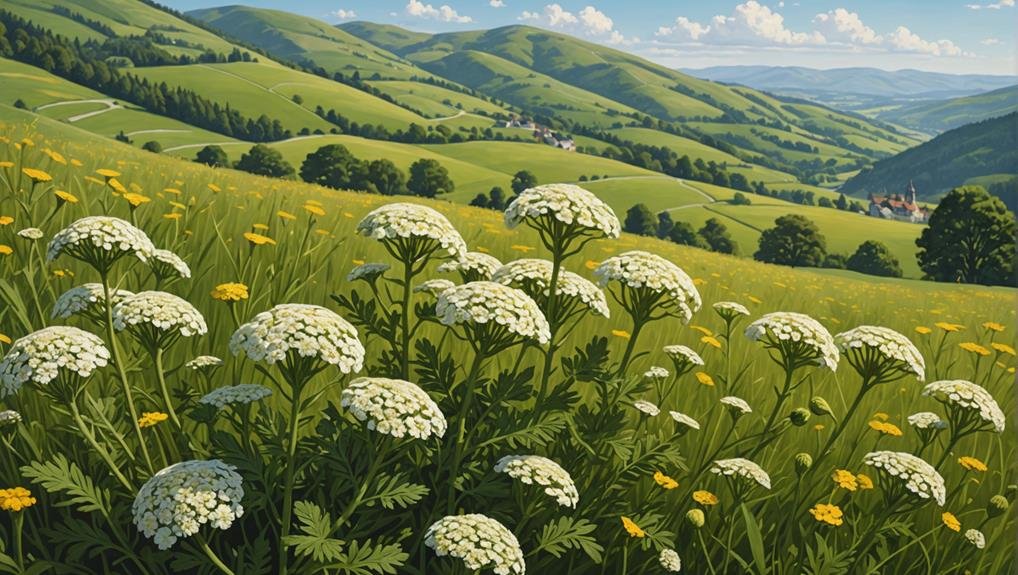
Native to the northern hemisphere, yarrow thrives in the wild landscapes of Europe and temperate regions of Asia. This resilient plant, belonging to the Asteraceae family, has adapted to a variety of climates and terrains, which contributes to its widespread presence and historical importance.
Yarrow's geographical origins are diverse, extending beyond Europe and Asia to include North America. The plant's ability to flourish in different environments underscores its versatility and appeal for use in wedding floral arrangements. Yarrow's presence in North America is particularly remarkable, as it has naturalized across many regions, adding to its global footprint.
To visualize yarrow's distribution:
- Europe: Found in meadows, grasslands, and roadsides.
- Asia: Thrives in temperate regions, particularly in countries like China and Japan.
- North America: Widely naturalized, prominently featured in wildflower meadows.
- Varied Climates: Grows in both coastal and inland areas, showcasing its adaptability.
- Historical Sites: Associated with ancient battlegrounds and mythological tales.
Understanding yarrow's geographical origins provides a deeper appreciation of its resilience and the diverse habitats it occupies. This knowledge not only enhances its allure for wedding arrangements but also underscores its historical and cultural importance across the globe.
Season Availability
Thriving in diverse climates, yarrow's year-round availability makes it an ideal choice for wedding floral arrangements across all seasons. This perennial favorite seamlessly fits into the wedding season of any couple's dreams, providing a consistent and reliable option for florists and planners alike.
During spring and summer, yarrow stands out with its vibrant colors, adding a lively touch to bouquets and centerpieces. The flowers' bright hues, ranging from sunny yellows to soft pinks, complement the fresh and blossoming ambiance of these seasons. Additionally, yarrow's robust nature ensures it remains fresh and beautiful even in the warmer months.
For those planning autumn weddings, yarrow continues to be a standout choice. Easily sourced in the fall, its earthy tones and rustic appeal align perfectly with the season's warm, golden palette. Yarrow's versatility allows it to enhance both the understated elegance of intimate gatherings and the grandeur of larger celebrations.
Even winter weddings can benefit from yarrow's enduring presence. Despite the colder months, yarrow remains available, offering a touch of natural beauty that can contrast elegantly with winter's stark landscapes. Consequently, yarrow's consistent season availability solidifies its place as a versatile and dependable choice for weddings year-round.
Growing Conditions
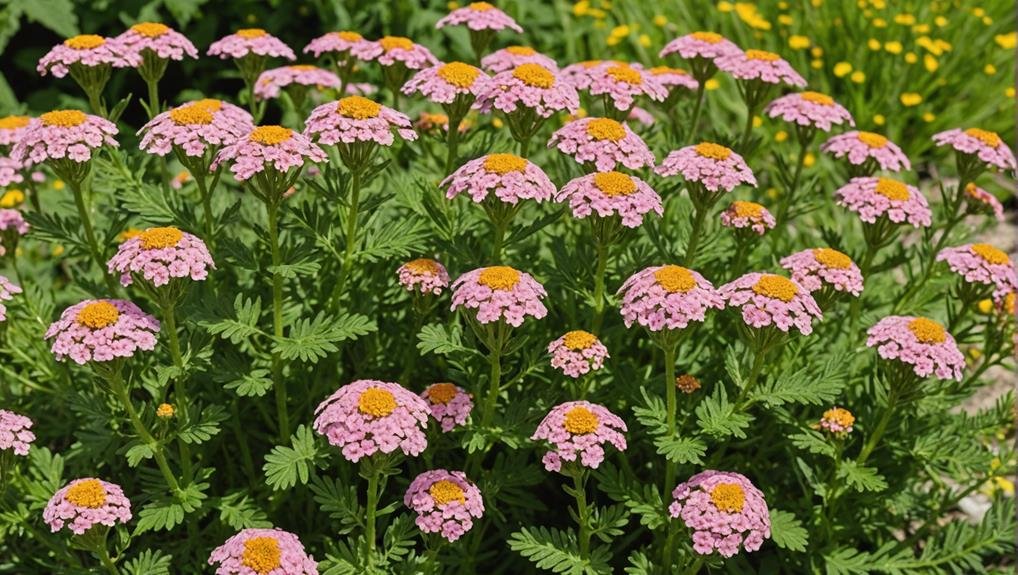
Understanding the ideal growing conditions for yarrow is essential to ensuring its year-round availability for wedding floral arrangements. Yarrow is a hardy perennial that thrives under specific conditions, making it a reliable choice for florists and gardeners alike.
For best growth, yarrow requires:
- Full Sun: Yarrow flourishes best when exposed to ample sunlight, ensuring robust and healthy blooms.
- Good Drainage: Proper drainage is vital to prevent waterlogging, which can lead to root rot, particularly during winter.
- Moderate Moisture: While yarrow is drought-tolerant, maintaining moderate soil moisture supports its growth without oversaturation.
- Proper Spacing: Adequate spacing between plants is necessary to allow air circulation and reduce the risk of disease.
- Time to Bloom: Yarrow typically takes at least one year to bloom from seed, requiring patience and planning for future floral arrangements.
Cultural Significance
Yarrow's rich cultural significance spans from ancient Greek mythology to its historical use in battlefield medicine. Named after the Greek hero Achilles, yarrow was reputedly used by him to heal soldiers' wounds, thereby embedding itself in cultural lore as a symbol of protection and healing. The botanical name Achillea millefolium reflects this legendary association.
In Greek mythology, yarrow is a symbol of love, protection, and healing. These attributes have transcended time, with soldiers across various cultures carrying yarrow for its believed protective and medicinal properties. This historical reverence underscores yarrow's enduring appeal and its significance beyond mere aesthetics.
As wedding flowers, yarrow's cultural roots add a layer of meaning to floral arrangements. Its symbolism of love and protection makes it a fitting choice for wedding ceremonies, where such themes are paramount. The flower's storied past and its associations with enduring love and care render it a meaningful inclusion in wedding floral designs.
Choosing yarrow as part of wedding flowers not only brings a touch of historical depth but also imbues the celebration with sentiments of protection and healing, aligning beautifully with the essence of matrimonial union.
Typical Use in Weddings
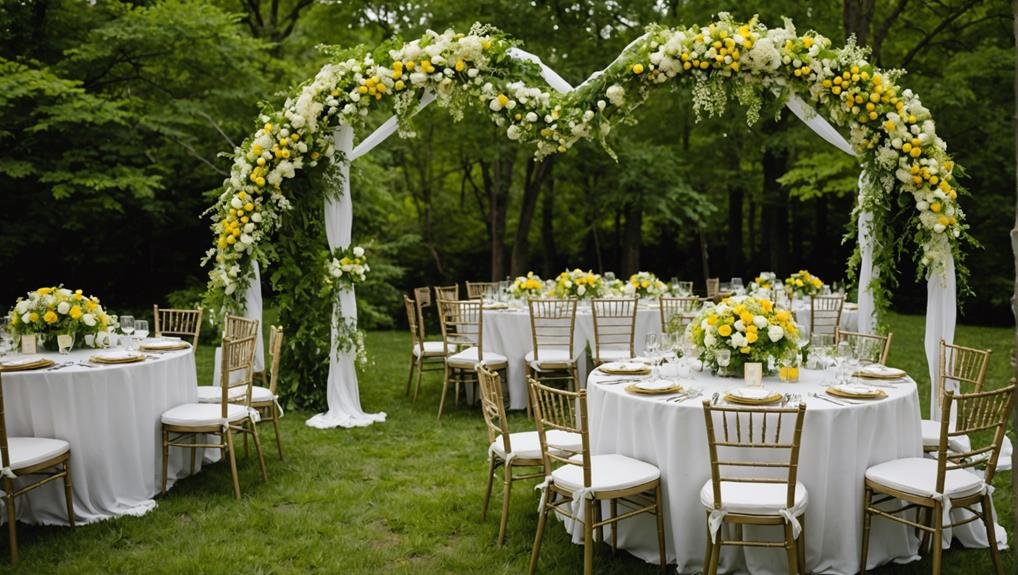
Building on its rich cultural significance, yarrow's typical use in weddings showcases its versatility and enduring appeal as a cherished floral element. This vibrant and resilient flower, known for its feathery foliage and array of colors, is a favorite among brides and florists alike. Its symbolic meanings of love and protection make it a fitting addition to wedding celebrations, where it enhances both aesthetic and emotional aspects.
Yarrow's adaptability allows it to blend seamlessly with other flowers, adding texture and a touch of natural beauty to various floral arrangements. Particularly favored in DIY wedding projects, yarrow's deep mustard and yellow tones evoke a wildflower vibe that perfectly complements rustic and bohemian themes. Additionally, its availability year-round and long vase life of 7-10 days make it a practical choice for any wedding season.
Common uses of yarrow in weddings include:
- Bouquets: Yarrow adds depth and texture to bridal and bridesmaid bouquets.
- Centerpieces: Its vibrant hues make for eye-catching table arrangements.
- Boutonnieres: A small sprig of yarrow creates a charming accent for the groom and groomsmen.
- Floral Crowns: Perfect for a boho-chic bride or flower girl.
- Aisle Decorations: Line the aisle with yarrow for a whimsical touch.
Alternative Flower Types
While yarrow offers numerous benefits, considering alternative flower types can provide additional inspiration and variety for wedding floral arrangements.
One such alternative is the hydrangea, known for its large, lush flower clusters that can easily be matched to any wedding color scheme. Hydrangeas are particularly versatile, available in hues ranging from delicate pastels to deep, rich tones, making them suitable for various themes and seasons.
Another excellent option is the peony, celebrated for its luxurious, full blooms and romantic appeal. Peonies are often sought after for their soft, yet striking colors, adding a touch of elegance to wedding bouquets and centerpieces. Their availability in shades of pink, white, and red allows for seamless integration into diverse wedding color palettes.
For those seeking a more rustic or whimsical look, consider incorporating wildflowers like daisies or Queen Anne's lace. These flowers, with their natural and unstructured flower clusters, evoke a charming, countryside aesthetic.
Additionally, roses remain a timeless choice, offering a classic beauty and a wide range of colors to suit any wedding theme.
